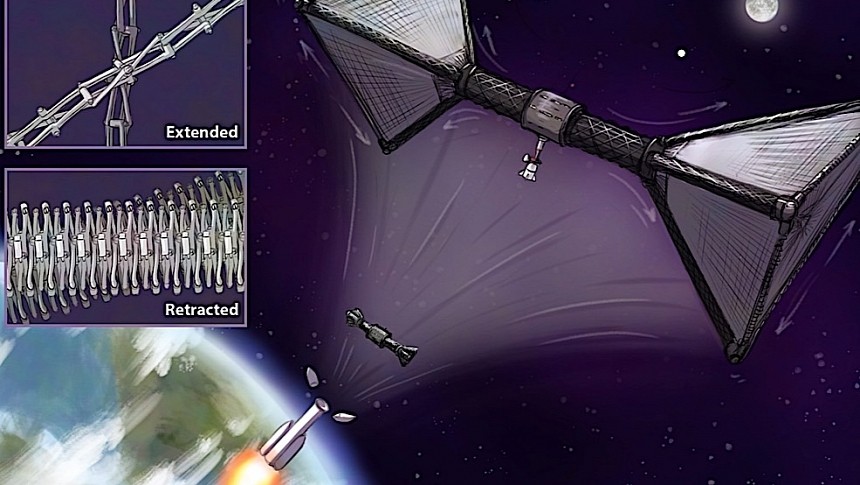Humans have been traveling to space for more than six decades now, and for a large part of that timeframe, some of us have even been living up there. But despite the many years that have passed since the first spaceflight, we're nowhere near making our space habitats look and feel even remotely like the ones here on Earth.
Take gravity for instance. Despite several attempts and projects, none of our space stations have been able so far to provide some kind of gravity for astronauts. And while for some that might not be such a big deal (after all, people have been living in zero-g for years, and they're fine overall), it does put some limits to how far we can expand.
Sure, our planet's orbit, the Moon, and even Mars are very well within reach by means of zero-g ships, but if we want to go even further, or truly live in space, artificial gravity is needed. Just take into account all the health issues that arise from long exposure to zero-g.
One of the easiest ways to generate gravity on a spaceship is to make it spin. After all, that's how the Earth and all other planets do it. And it's quite easy to achieve, if only humans could withstand rapid spinning motions.
You see, the smaller the ship the faster it needs to spin to generate gravity. And since most humans can't take rotation rates higher than three rpm (two rpm are ideal to avoid motion sickness), that translates into spinning space habitats that are kilometer-scale. And we simply can't build that at the moment.
But we might be able to, if an idea by Carnegie Mellon University's Zac Manchester comes through. And it just might, as last year it got NASA recognition, and a push into Phase II of the Innovative Advanced Concepts (NIAC) program.
The idea is called HERDS. That's an acronym for high-expansion-ratio deployable structure, and it's supposed to launch from Earth in a compact form, then expand in space to the desired size.
According to Manchester, the idea uses something called mechanical metamaterials, meaning structures whose properties are defined by the way they are arranged rather than what they're made of. For this application, metamaterials called shearing auxetics and branched scissor mechanisms are to be used, and as per the initial data they should allow for an expansion ratio of 150 for tube structures.
The idea is still a long way from becoming a reality, with the team working on it now busy going around issues identified so far, including jamming during deployment. Plans are however to move into the design and testing of meter-scale models to validate the idea, which could also be used to build really, really big telescopes.
Until HERDS becomes a reality for space structure building, it's likely some other creation will take the title for the world's first space station with an artificial gravity. Most recently, a startup called Vast came into the spotlight with such an idea, as it plans to start building an artificial gravity space station in 2025.
Sure, our planet's orbit, the Moon, and even Mars are very well within reach by means of zero-g ships, but if we want to go even further, or truly live in space, artificial gravity is needed. Just take into account all the health issues that arise from long exposure to zero-g.
One of the easiest ways to generate gravity on a spaceship is to make it spin. After all, that's how the Earth and all other planets do it. And it's quite easy to achieve, if only humans could withstand rapid spinning motions.
You see, the smaller the ship the faster it needs to spin to generate gravity. And since most humans can't take rotation rates higher than three rpm (two rpm are ideal to avoid motion sickness), that translates into spinning space habitats that are kilometer-scale. And we simply can't build that at the moment.
But we might be able to, if an idea by Carnegie Mellon University's Zac Manchester comes through. And it just might, as last year it got NASA recognition, and a push into Phase II of the Innovative Advanced Concepts (NIAC) program.
The idea is called HERDS. That's an acronym for high-expansion-ratio deployable structure, and it's supposed to launch from Earth in a compact form, then expand in space to the desired size.
According to Manchester, the idea uses something called mechanical metamaterials, meaning structures whose properties are defined by the way they are arranged rather than what they're made of. For this application, metamaterials called shearing auxetics and branched scissor mechanisms are to be used, and as per the initial data they should allow for an expansion ratio of 150 for tube structures.
The idea is still a long way from becoming a reality, with the team working on it now busy going around issues identified so far, including jamming during deployment. Plans are however to move into the design and testing of meter-scale models to validate the idea, which could also be used to build really, really big telescopes.
Until HERDS becomes a reality for space structure building, it's likely some other creation will take the title for the world's first space station with an artificial gravity. Most recently, a startup called Vast came into the spotlight with such an idea, as it plans to start building an artificial gravity space station in 2025.







